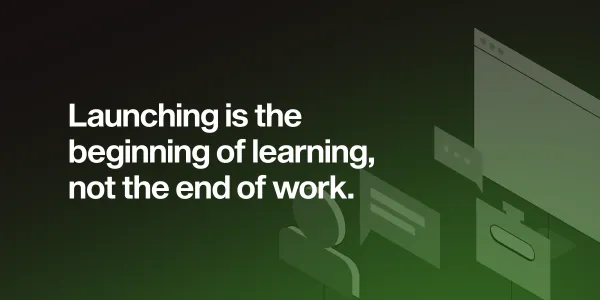How to Validate Digital Product Ideas Before Development
Validating your digital product idea early prevents wasted time and budget. Haris reveals seven essential 2025-ready methods: AI-powered surveys, rapid user testing, competitor benchmarking, and more; all to ensure real demand before writing a single line of code.

Every digital product begins as an idea. But not every idea becomes a product users want.
Before writing code or designing features, there is a step that helps determine if the idea is worth building. This step is called validation.
In 2025, digital product validation has become more precise. Teams use data, AI tools, and fast testing methods to check if an idea solves a real problem for real users.
What Is Digital Product Validation?
Digital product validation is the process of testing whether a product idea solves a specific problem for a defined target audience before starting full development.
It helps reduce risk by identifying whether the product has real demand.
In 2025, validation uses tools like AI-powered surveys, user behavior analytics, and real-time market signals to collect early insights.
Key components of validation:
- Problem identification
- Target audience definition
- Market demand verification
- Competitive analysis
- Early user feedback collection
Studies show that products that undergo proper validation are more likely to succeed in the market than those that don't.

Why Validation Matters In 2025
In 2025, digital product development moves faster than ever. Skipping validation often results in wasted time and resources.
Validation typically costs much less than full development. It helps teams avoid large expenses by testing their assumptions early.
By validating early, teams focus only on features that users have shown interest in. This reduces the number of changes needed later and shortens the time to launch.
For example, Dropbox created a simple explainer video before building their product. Thousands of users signed up, confirming market demand before a single line of code was written.
This approach connects the dots between what developers think users want and what users actually need.
Identifying The Real Problem And Target Audience
Digital product validation begins with identifying a real problem. The focus is on the user's pain point, not the product itself.
Defining the target audience involves creating a complete customer profile that includes:
- Demographics (age, income, location)
- Psychographics (attitudes, interests, values)
- Behaviors (how users currently solve the problem)
To confirm the problem exists, conduct interviews with potential users. Ask open-ended questions like:
- "What challenges do you face when trying to accomplish X?"
- "How do you currently solve this problem?"
- "What frustrates you about current solutions?"
A simple format for stating the problem is: "Our product helps [target audience] who struggle with [specific problem] by providing [unique solution]."
This stage focuses on seeing the big picture – understanding both the forest (the market) and the trees (individual user needs).
Establishing Market Viability Through Analysis
To find out if a digital product idea is worth building, check if there is a real market for it. This involves analyzing competitors and measuring demand signals.
1. Competitive Landscape
The competitive landscape includes other products solving similar problems. To study this effectively:
- List direct competitors (solving the same problem in the same way)
- Identify indirect competitors (solving the same problem differently)
- Analyze their strengths and weaknesses
- Look for gaps in their offerings
Market gap analysis: After mapping competitors, look for unmet needs or underserved segments. These gaps often represent opportunities for your product to provide unique value.
Tools like SimilarWeb and Crayon can help analyze competitor websites, features, and marketing approaches.
2. Demand Signals
Demand signals show whether people are actively looking for solutions to the problem your product addresses.
Key metrics to track include:
- Search volume for related keywords
- Social media conversations about the problem
- Forum discussions and question frequency
- Interest in related products or services
For example, increasing search volume for terms related to your product idea can indicate growing market demand. Similarly, active discussions in online communities suggest the problem is real and important to users.
Google Trends, Brand24, and social listening tools can help track these signals in real-time, providing valuable data for product validation.
Gathering Early Feedback With MVP Tests
Minimum Viable Product (MVP) testing uses a basic version of a product to collect early feedback. This helps identify what users actually want before investing in full development.
1. Surveys And Interviews
Surveys and interviews collect direct feedback from potential users. When designing surveys:
- Keep them short (5-7 questions)
- Include both multiple-choice and open-ended questions
- Avoid leading questions that suggest a "right" answer
- Ask about the problem first, then potential solutions
For interviews, aim for 15-20 conversations with people who match your target audience. Record and transcribe these discussions to identify patterns in responses.
Interview tip: Let the conversation flow naturally. Often, the most valuable insights come from follow-up questions and spontaneous discussions.

2. Landing Pages And Sign-Ups
A landing page is a simple website that explains your product idea and includes a call-to-action. It measures interest before the product exists.
Effective landing pages include:
- A clear headline describing the problem you solve
- A brief explanation of your solution
- Visual elements (mockups or diagrams)
- A strong call-to-action ("Join the waitlist," "Get early access")
Track the conversion rate (percentage of visitors who sign up) to gauge interest. A rate of 10-15% often indicates strong demand for B2C products, while 20-30% is excellent for B2B products.
Tools like Unbounce or Carrd make creating landing pages quick and easy, even without technical skills.
3. Simple Prototypes Or Smoke Tests
A prototype shows how your product might work without requiring full development. It can be as simple as a series of linked screens or as complex as a working demo with limited functionality.
No-code tools like Figma and Bubble allow you to create interactive prototypes quickly. These tools help users experience your product idea before it's built.
When testing prototypes, watch how users interact with them. Do they understand the core concept? Can they complete basic tasks? What questions or confusion arise?
This feedback helps refine your product concept before investing in development.
Leveraging AI And Real-Time Data For Validation
In 2025, AI and real-time data have transformed how teams validate digital product ideas. These tools provide faster, more accurate insights into market needs and user preferences.
1. AI-Powered Surveys
AI-powered surveys go beyond collecting responses – they analyze patterns and extract insights automatically.
Benefits of AI surveys:
- Pattern recognition: AI identifies themes across hundreds of responses
- Sentiment analysis: Detects positive, negative, or neutral feelings about concepts
- Predictive insights: Suggests potential features based on user needs
For example, an AI survey might reveal that users mention "time-saving" frequently in their responses, indicating this should be a key benefit of your product.
Tools like Typeform with AI analysis and SurveyMonkey now include these capabilities, making sophisticated research accessible to teams of all sizes.
2. Real-Time Monitoring Tools
Real-time monitoring tracks online conversations about problems related to your product idea. This provides ongoing validation data without requiring direct user interaction.
Set up alerts for:
- Keywords related to the problem you solve
- Competitor mentions
- Industry trends and news
This approach creates an extraordinary support network of information, helping you spot opportunities and threats as they emerge.
For example, if users suddenly start complaining about a competitor's new feature, you can adapt your product to address those concerns before launch.
Practical Methods To Refine Your Concept
Validation is an ongoing process. As you collect feedback, use it to refine your product concept continuously.
1. Ongoing User Feedback
Create a system for collecting and organizing user feedback throughout the validation process.
Simple ways to gather ongoing feedback include:
- Follow-up emails to survey respondents
- User testing sessions with prototype updates
- Community forums or Slack channels
- Social media engagement
When organizing feedback, separate "must-have" features (essential to solving the core problem) from "nice-to-have" features (enhancements that can come later).
This approach helps maintain strategic partnerships with early users by showing you value their input while staying focused on the most important elements.
2. Iteration And Feature Prioritization
Use validation data to decide which features to build first, which to delay, and which to remove entirely.
The Impact vs. Effort matrix helps prioritize features by comparing their value to users against the resources required to build them:
| Feature Type | Description | Example |
|---|---|---|
| High Impact, Low Effort | Build these first | One-click login |
| High Impact, High Effort | Plan carefully | AI recommendation engine |
| Low Impact, Low Effort | Consider including | Dark mode option |
| Low Impact, High Effort | Avoid or delay | Custom integrations |
This matrix helps teams see the big picture while making practical decisions about what to build and when.
Creating A Launch-Ready Validation Roadmap
A validation roadmap organizes all the steps needed to test a digital product idea thoroughly. It creates a clear path from concept to validated product ready for development.
The roadmap typically includes these milestones:
- Problem and audience definition
- Market demand confirmation
- Competitor analysis
- MVP testing and feedback collection
- Feature prioritization
- Go/no-go decision

Signs you're ready to proceed to development:
- Consistent user interest: People regularly express enthusiasm for your solution
- Willingness to pay: Users indicate they would pay for your product
- Clear differentiation: Your solution offers something meaningfully different from alternatives
- Validated problem: You've confirmed the problem is real and important to users
At Ministry of Programming, we've seen that the most successful products come from teams who connect all these dots before starting development. With 100+ products in our portfolio and partners from 11 countries, we've learned that validation is the foundation of product success.
Ready to move from validated idea to development?
Frequently Asked Questions About Validating Digital Product Ideas
How much should I budget for product validation before development?
Product validation typically requires 10-15% of the total product development budget. This investment in early testing significantly reduces the risk of building something users don't want.
What validation metrics indicate I should proceed with development?
Look for consistent user enthusiasm, a waitlist conversion rate above 10%, and clear differentiation from existing solutions that addresses validated pain points.
How do I validate a digital product idea if my target market is highly specialized?
Focus on quality over quantity by conducting in-depth interviews with industry experts, joining specialized forums, and creating targeted landing pages with industry-specific messaging.
What is the minimum sample size needed for reliable validation results?
For interviews, aim for 15-20 participants until you start hearing the same themes repeatedly. For surveys, collect at least 100 responses from your target audience for statistically meaningful results.



